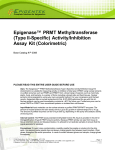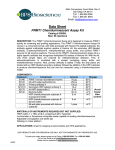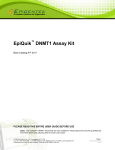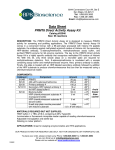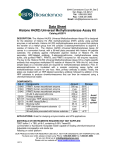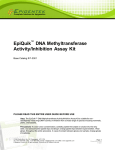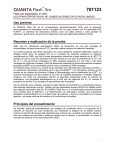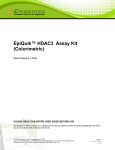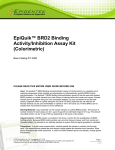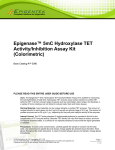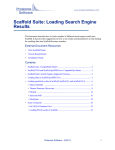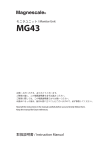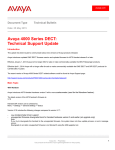Download EpiQuik™ Global Di-Methyl Histone H4R3
Transcript
EPIGENTEK Complete Solutions for Epigenetics EpiQuik™ Global Di-Methyl Histone H4R3 Quantification Kit (Colorimetric) Base Catalog # P-3090 PLEASE READ THIS ENTIRE USER GUIDE BEFORE USE Uses: The EpiQuik™ Global Di-Methyl Histone H4R3 Quantification Kit (Colorimetric) is suitable for specifically measuring global histone H4 arginine 3 di-methylation from a broad range of species such as mammals, plants, fungi, and bacteria, in a variety of forms including cultured cells and fresh tissues. Histone extracts can be prepared by using your own successful method. For your convenience and the best results, Epigentek offers a histone extraction kit (Cat. # OP-0006) optimized for use with this kit. Histone extracts can be used immediately or stored at –80°C for future use. Input Material: Input materials can be histone extracts or nuclear extracts. The amount of histone extracts for each assay can be 0.1 µg to 2 µg with an optimal range of 0.5 to 1 µg. Internal Control: The assay control (methylated histone H4-Arg 3) is provided in this kit for the quantification of global di-methyl histone H4R3. Because content of di-methyl histone H4R3 can vary from tissue to tissue, and from normal and diseased states, it is advised to run replicate samples to ensure that the signal generated is validated. Precautions: To avoid cross-contamination, carefully pipette the sample or solution into the strip wells. Use aerosol-barrier pipette tips and always change pipette tips between liquid transfers. Wear gloves throughout the entire procedure. In case of contact between gloves and sample, change gloves immediately. 110 Bi County Blvd. Ste. 122, Farmingdale, NY 11735 Tel: 1-877-374-4368 ■ Fax: 1-718-484-3956 ■ E-mail: [email protected] ■ Web: www.epigentek.com © Epigentek Group Inc. All rights reserved. Products are for research use only. Page 1 Printed 2015-06-23 P-3090 EPIGENTEK Complete Solutions for Epigenetics KIT CONTENTS Component 48 Assays Cat. #P-3090-48 96 Assays Cat. #P-3090-96 Storage Upon Receipt WB (10X Wash Buffer) 14 ml 28 ml 4°C HB (Histone Buffer) 4 ml 8 ml 4°C BB (Blocking Buffer) 10 ml 20 ml 4°C MER3 (Capture Antibody, 1000X)* 5 µl 10 µl 4°C RDA (Detection Antibody, 2000X)* 6 µl 12 µl –20°C ES (Enhancer solution) 6 µl 12 µl –20°C DS (Developer Solution) 5 ml 10 ml 4°C SS (Stop Solution) 5 ml 10 ml RT Di-Methyl H4R3 control ( 50 µg/ml) 10 µl 20 µl –20°C 8-Well Assay Strips (With Frame) 6 12 4°C Adhesive Covering Film 1 1 RT User Guide 1 1 RT * Spin the solution down to the bottom prior to use. SHIPPING & STORAGE The kit is shipped in three parts: the first part at ambient room temperature, and the second and third parts on frozen ice packs at 4°C. Upon receipt: (1) Store RDA, ES, and Di-Methyl H4R3 control at – 20°C away from light; (2) Store WB, HB, BB, MER3, DS, and 8-Well Assay Strips at 4°C away from light; and (3) Store remaining components (SS and Adhesive Covering Film) at room temperature away from light. All components of the kit are stable for 6 months from the date of shipment, when stored properly. Note: (1) Check if WB (10X Wash Buffer) contains salt precipitates before use. If so, warm (at room temperature or 37°C) and shake the buffer until the salts are re-dissolved; and (2) check if a blue color present in DS (Developer Solution), which would indicate contamination of the solution and should not be used. To avoid contamination, transfer the amount of DS required into a secondary container (tube or vial) before adding DS into the assay wells. MATERIALS REQUIRED BUT NOT SUPPLIED Adjustable pipette or multiple-channel pipette Multiple-channel pipette reservoirs Aerosol resistant pipette tips Microplate reader capable of reading absorbance at 450 nm 1.5 ml microcentrifuge tubes Incubator for 37°C incubation 110 Bi County Blvd. Ste. 122, Farmingdale, NY 11735 Tel: 1-877-374-4368 ■ Fax: 1-718-484-3956 ■ E-mail: [email protected] ■ Web: www.epigentek.com © Epigentek Group Inc. All rights reserved. Products are for research use only. Page 2 Printed 2015-06-23 P-3090 EPIGENTEK Complete Solutions for Epigenetics Distilled water Histone extracts Parafilm M or aluminum foil GENERAL PRODUCT INFORMATION Quality Control: Each lot of the EpiQuik™ Global Di-Methyl Histone H4R3 Quantification Kit (Colorimetric) is tested against predetermined specifications to ensure consistent product quality. Epigentek guarantees the performance of all products in the manner described in our product instructions. Product Warranty: If this product does not meet your expectations, simply contact our technical support unit or your regional distributor. We also encourage you to contact us if you have any suggestions about product performance or new applications and techniques. Safety: Suitable lab coat, disposable gloves, and proper eye protection are required when working with this product. Product Updates: Epigentek reserves the right to change or modify any product to enhance its performance and design. The information in this User Guide is subject to change at any time without notice. Thus, only use the User Guide that was supplied with the kit when using that kit. Usage Limitation: The EpiQuik™ Global Di-Methyl Histone H4R3 Quantification Kit (Colorimetric) is for research use only and is not intended for diagnostic or therapeutic application. A BRIEF OVERVIEW Arginine histone methylation is one of the many important epigenetic marks, and is essential for the regulation of multiple cellular processes. Arginine methylation of histones H3 (Arg2, 8, 17, 26) and H4 (Arg3) promotes transcriptional activation and is mediated by a family of protein arginine methyltransferases (PRMTs). There are 9 types of PRMTs found in humans but only 7 members are reported to methylate histones. They can mediate mono or dimethylation of arginine residues. These enzymes use S-adenosyl-methionine (SAM) as a methyl donor and transfer it to the guanidinium side chain of arginine. Based on the position of methyl group addition, the PRMTs can be classified into type I (CARM1, PRMT1, PRMT2, PRMT3, PRMT6, and PRMT8) and type II (PRMT5 and PRMT7). 110 Bi County Blvd. Ste. 122, Farmingdale, NY 11735 Tel: 1-877-374-4368 ■ Fax: 1-718-484-3956 ■ E-mail: [email protected] ■ Web: www.epigentek.com © Epigentek Group Inc. All rights reserved. Products are for research use only. Page 3 Printed 2015-06-23 P-3090 EPIGENTEK Complete Solutions for Epigenetics Fig. 1. Histone arginine methylation reaction catalyzed by PRMTs. Symmetric di-methylation of histone H4 arg3 (H4R3) is catalyzed by type II PRMTs, which are found to be strongly implicated in diseases like cancer. For example, PRMT5 plays a role in the repression of certain tumor suppressor genes such as RB tumor suppressors while PRMT7 overexpression is observed in breast cancer. The global H4R3 di-methylation can be changed by inhibition or activation of type II PRMTs. Therefore, quantitative detection of global symmetric di-methyl histone H4R3 would provide useful information for better understanding epigenetic regulation of gene activation and silencing, as well as for developing PRMT-targeted drugs. The EpiQuik™ Global Di-Methyl Histone H4R3 Quantification Kit (Colorimetric) is designed to quantitatively detect global di-methyl histone H4R3. This kit has the following advantages: Quick and efficient procedure, which can be finished within 3.5 hours. Innovative colorimetric chromatography. Specifically captures symmetric di-methylated H4R3 with the detection limit as low as 0.5 ng/well and detection range from 100 ng to 2 µg/well of histone extracts. The control is conveniently included for the quantification of di-methylated H4R3. Strip microplate format makes the assay flexible: manual or high throughput. Simple, reliable, and consistent assay conditions. assay without the need for radioactivity, electrophoresis, or PRINCIPLE & PROCEDURE The EpiQuik™ Global Di-Methyl Histone H4R3 Quantification Kit (Colorimetric) is designed for measuring global histone H4R3 di-methylation. In an assay with this kit, the histone proteins are stably spotted on the strip wells. The di-methyl histone H4R3 can be recognized with a high-affinity antibody and detected with a detection antibody, followed by a color development reagent. The ratio of dimethylated H4R3 is proportional to the intensity of absorbance. The absolute amount of di-methylated H4R3 can be quantitated by comparing to the standard control. 110 Bi County Blvd. Ste. 122, Farmingdale, NY 11735 Tel: 1-877-374-4368 ■ Fax: 1-718-484-3956 ■ E-mail: [email protected] ■ Web: www.epigentek.com © Epigentek Group Inc. All rights reserved. Products are for research use only. Page 4 Printed 2015-06-23 P-3090 EPIGENTEK Complete Solutions for Epigenetics 12 Di-methyl H4-R3 (ng) 10 8 6 4 2 0 0 0.5 1 1.5 2 Histone extracts (µg) Histone extracts were prepared from MDA-231 cells using the EpiQuik™ Total Histone Extraction Kit and the amount of dimethyl-H4R3 was measured using the EpiQuik™ Global Dimethyl Histone H4R3 Quantification Kit (Colorimetric). 1 R2 = 0.9909 0.8 OD450 nm Schematic procedure of the EpiQuik™ Global Di-Methyl Histone H4R3 Quantification Kit (Colorimetric) 0.6 0.4 0.2 0 0 2 4 6 8 10 Di-methyl H4R3 control( ng) Illustrated standard curve generated with di-methyl H4R3 control. PROTOCOL For the best results, please read the protocol in its entirety prior to starting your experiment Starting Materials Input Amount: The amount of histone extracts for each assay can be between 0.1 µg and 2 ug with an optimal range of 0.2 to 0.5 µg. 110 Bi County Blvd. Ste. 122, Farmingdale, NY 11735 Tel: 1-877-374-4368 ■ Fax: 1-718-484-3956 ■ E-mail: [email protected] ■ Web: www.epigentek.com © Epigentek Group Inc. All rights reserved. Products are for research use only. Page 5 Printed 2015-06-23 P-3090 EPIGENTEK Complete Solutions for Epigenetics Histone Extraction: You can use your method of choice for preparing histone extracts from the treated and untreated samples. Epigentek also offers a histone extraction kit (Cat # OP-0006) optimized for use with this kit. Histone extracts should be stored in aliquots at –80°C until use. 1. Working Buffer and Solution Preparation a. Prepare Diluted WB 1X Wash Buffer: 48-Assay Kit: Add 13 ml of WB 10X Wash Buffer to 117 ml of distilled water and adjust pH to 7.2-7.5. 96-Assay Kit: Add 26 ml of WB 10X Wash Buffer to 234 ml of distilled water and adjust pH to 7.2-7.5. This Diluted WB 1X Wash Buffer can now be stored at 4°C for up to six months. b. Prepare Diluted MER3 Capture Antibody Solution: Dilute MER3 Capture Antibody with Diluted WB 1X Wash Buffer at a ratio of 1:1000 (i.e., add 1 µl of MER3 to 1000 µl of Diluted WB). 50 µl of Diluted MER3 will be required for each assay well. c. Prepare Diluted RDA Detection Antibody Solution: Dilute RDA Detection Antibody with Diluted WB 1X Wash Buffer at a ratio of 1:2000 (i.e., add 1 µl of RDA to 2000 µl of Diluted WB). 50 µl of Diluted RDA will be required for each assay well. d. Prepare Diluted ES Enhancer Solution: Dilute ES Enhancer Solution with Diluted WB 1X Wash Buffer at a ratio of 1:5000 (i.e., add 1 µl of Wash Buffer at a ratio of 1:5000 (i.e., add 1 µl of ES to 5000 µl of WB). About 50 µl of this Diluted ES will be required for each assay well. e. Prepare Diluted di-methyl H4R3 Control Standard Suggested Standard Curve Preparation: First, dilute H4R3 Control with HB histone buffer to 10 ng/µl by adding 2 µl of H4R3 Control to 8 µl of HB histone buffer. Then, further prepare five concentrations by combining the 10 ng/µl Diluted H4R3 Control with HB into final concentrations of 0.5, 1, 2, 5, and 10 ng/µl according to the following dilution chart: Tube H4R3 (20 ng/µl) HB Resulting H4R3 Concentration 1 1.0 µl 19.0 µl 0.5 ng/µl 2 1.0 µl 9.0 µl 1 ng/µl 3 1.0 µl 4.0 µl 2 ng/µl 4 2.0 µl 2.0 µl 5 ng/µl 5 4.0 µl 0.0 µl 10 ng/µl Note: Keep each of the diluted solutions except WB 1X Wash Buffer on ice until use. Any remaining diluted solutions other than Diluted WB should be discarded if not used within the same day. 110 Bi County Blvd. Ste. 122, Farmingdale, NY 11735 Tel: 1-877-374-4368 ■ Fax: 1-718-484-3956 ■ E-mail: [email protected] ■ Web: www.epigentek.com © Epigentek Group Inc. All rights reserved. Products are for research use only. Page 6 Printed 2015-06-23 P-3090 EPIGENTEK Complete Solutions for Epigenetics 2. Histone Binding a. Predetermine the number of strip wells required for your experiment. It is advised to run replicate samples (include blank and positive controls) to ensure that the signal generated is validated. Carefully remove un-needed strip wells from the plate frame and place them back in the bag (seal the bag tightly and store at 4°C). b. Blank Wells: Add 49 µl of HB to each blank well. c. Standard Wells: Add 49 µl of HB and 1 µl of Diluted H4R3 control to each standard well with a minimum of five wells, each at a different concentration between 0.5 and 10 ng/µl (based on the dilution chart in Step 1e; see Table 2 under the “Suggested Strip Well Setup” section as an example). d. Sample Wells: Add 46 to 49 µl of HB and 1 to 4 µl of your histone extracts. Total volume should be 50 µl per well. Note: (1) Follow the suggested well setup diagrams; (2) It is recommended to use 0.2 µg to 0.5 µg of histone extract per well. e. Tightly cover strip-well microplate with Adhesive Covering Film to avoid evaporation and incubate at 37°C for 90 to 120 min. Note: The Adhesive Covering Film can be cut to the required size to cover the strips based on the number of strips to be used. f. Remove the reaction solution from each well. Add 150 µl of BB block buffer to each well, then cover with Parafilm M or aluminium foil and incubate at 37°C for 30 min. g. Remove the reaction solution from each well. Wash each well three times with 150 µl of the Diluted WB 1X Wash Buffer each time. 3. Antibody Binding and Signal Enhancing a. Add 50 µl of the Diluted MER3 to each well, then cover with Parafilm M or aluminium foil and incubate at room temperature for 60 min. b. Remove the Diluted MER3 solution from each well. c. Wash each well three times with 150 µl of the Diluted WB each time. d. Add 50 µl of the Diluted RDA to each well, then cover with Parafilm M or aluminium foil and incubate at room temperature for 30 min. e. Remove the Diluted RDA solution from each well. f. Wash each well four times with 150 µl of the Diluted WB each time. g. Add 50 µl of the Diluted ES to each well, then carefully cover with Parafilm M or aluminium foil and incubate at room temperature for 30 min. h. Remove the Diluted ES solution from each well. i. Wash each well with 150 µl of the Diluted WB each time for five times. 110 Bi County Blvd. Ste. 122, Farmingdale, NY 11735 Tel: 1-877-374-4368 ■ Fax: 1-718-484-3956 ■ E-mail: [email protected] ■ Web: www.epigentek.com © Epigentek Group Inc. All rights reserved. Products are for research use only. Page 7 Printed 2015-06-23 P-3090 EPIGENTEK Complete Solutions for Epigenetics Note: Ensure any residual wash buffer in the wells is removed as much as possible at each wash step. 4. Signal Detection a. Add 100 µl of DS to each well and incubate at room temperature for 1 to 10 min away from light. Begin monitoring color change in the sample wells and control wells. The DS solution will turn blue in the presence of sufficient methylated products. b. Add 100 µl of SS to each well to stop enzyme reaction when color in the positive control wells turns medium blue. The color will change to yellow after adding SS and the absorbance should be read on a microplate reader within 2 to 10 min at 450 nm with an optional reference wavelength of 655 nm. Note: (1) Most microplate readers have the capability to carry out dual wavelength analysis and will automatically subtract reference wavelength absorbance from the test wavelength absorbance. If your plate reader does not have this capability, the plate can be read twice, once at 450 nm and once at 655 nm. Then, manually subtract the 655 nm ODs from 450 nm ODs; (2) If the strip-well microplate frame does not fit in the microplate reader, transfer the solution to a standard 96-well microplate. 5. Di-Methyl H4R3 Calculation a. Calculate the average duplicate readings for the sample wells and blank wells. b. Calculate % histone H4R3 di-methylation change using the following formula: Treated (Tested) Sample OD – Blank OD Di-Methyl H4R3% = x 100% Untreated (Control) Sample OD – Blank OD Example calculation: Average OD450 of treated sample is 0.5 Average OD450 of untreated control is 0.9 Average OD450 of blank is 0.1 Di-Methyl H4R3 % = (0.5 – 0.1) x 100% = 50% 0.9- 0.1 For accurate calculation: 1. 2. Generate a standard curve and plot OD value versus amount of H4R3 control at each concentration point. Determine the slope as OD/ng (you can use Microsoft Excel statistical functions for slope calculation), then calculate the amount of di-methyl H4R3 using the following formulas: (Sample OD – Blank OD) Di-Methyl H4R3 (ng/mg protein ) = x 1000 Slope x Protein Amount (ug*) * Histone extract added into sample wells at step 2d. 110 Bi County Blvd. Ste. 122, Farmingdale, NY 11735 Tel: 1-877-374-4368 ■ Fax: 1-718-484-3956 ■ E-mail: [email protected] ■ Web: www.epigentek.com © Epigentek Group Inc. All rights reserved. Products are for research use only. Page 8 Printed 2015-06-23 P-3090 EPIGENTEK Complete Solutions for Epigenetics SUGGESTED BUFFER AND SOLUTION SETUP Table 1. Approximate amount of required buffers and solutions for defined assay wells based on the protocol. Reagents 1 well 1 strip (8 wells) 2 strips (16 wells) 6 strips (48 wells) 12 strips (96 wells) Diluted WB 2.5 ml 20 ml 40 ml 120 ml 240 ml HB 50 µl 400 µl 800 µl 2400 µl 4800 µl BB 0.15 ml 1.2 ml 2.5 ml 7.5 ml 14.5 ml H4R3 control N/A N/A 4 µL (optional) 8 µl 8 µl Diluted MER3 50 µl 400 µl 800 µl 2400 µl 4800 µl Diluted RDA 50 µl 400 µl 800 µl 2400 µl 4800 µl Diluted ES 50 µl 400 µl 800 µl 2400 µl 4800 µl Developer Solution 0.1 ml 0.8 ml 1.6 ml 4.8 ml 9.6 ml Stop Solution 0.1 ml 0.8 ml 1.6 ml 4.8 ml 9.6 ml SUGGESTED STRIP WELL SETUP Table 2. The suggested strip-well plate setup for dimethyl H4R3 quantification in a 48-assay format (in a 96-assay format, Strips 7 to 12 can be configured as Sample). The controls and samples can be measured in duplicate. Well # A B C D E F G H Strip 1 Blank H4R3 0.5 ng H4R3 1 ng H4R3 2 ng H4R3 5 ng H4R3 10 ng Sample Sample Strip 2 Blank H4R3 0.5 ng H4R3 1 ng H4R3 2 ng H4R3 5 ng H4R3 10 ng Sample Sample Strip 3 Sample Sample Sample Sample Sample Sample Sample Sample Strip 4 Sample Sample Sample Sample Sample Sample Sample Sample Strip 5 Sample Sample Sample Sample Sample Sample Sample Sample Strip 6 Sample Sample Sample Sample Sample Sample Sample Sample TROUBLESHOOTING Problem Possible Cause Suggestion No signal or weak signal in both the positive control and sample wells Reagents are added incorrectly. Check if reagents are added in the proper order with the right amount, and if any steps in the protocol may have been omitted by mistake. Incubation time and temperature are incorrect. Ensure the incubation time and temperature described in the protocol are followed correctly. Incorrect absorbance reading. Check if appropriate absorbance wavelength (450 nm) is used. Kit was not stored or handled properly. Ensure all components of the kit were stored at the appropriate temperature and 110 Bi County Blvd. Ste. 122, Farmingdale, NY 11735 Tel: 1-877-374-4368 ■ Fax: 1-718-484-3956 ■ E-mail: [email protected] ■ Web: www.epigentek.com © Epigentek Group Inc. All rights reserved. Products are for research use only. Page 9 Printed 2015-06-23 P-3090 EPIGENTEK Complete Solutions for Epigenetics the cap is tightly capped after each opening or use. No signal or weak signal in only the standard curve wells The standard amount is insufficiently added to the well in Step 2c. Ensure a sufficient amount of standard is added. The standard is degraded due to improper storage conditions. Follow the Shipping & Storage guidance in this User Guide for storage of H4R3 Control. High background present in the blank wells Insufficient washing of wells. Check if washing recommendations at each step is performed according to the protocol. Contaminated by sample or standard. Ensure the well is not contaminated from adding sample or standard accidentally or from using contaminated tips. Incubation time with Diluted RDA is too long. The incubation time at Step 3d should not exceed 90 min. Over-development of color. Decrease the development time in Step 4a before adding SS Stop Solution in Step 4b. Protein sample is not properly extracted or purified. Ensure your protocol is suitable for histone protein extraction. For the best results, it is advised to use Epigentek’s histone extraction Kit (Cat. No. OP-0006). Sample amount added into the wells is insufficient. Ensure a sufficient amount of histone extracts is used as indicated in Step 2. The sample can be titrated to determine the optimal amount to use in the assay. Sample was not stored properly or has been stored for too long. Ensure sample is stored in aliquots at – 80°C, with no more than 6 months histone extracts.. Little or no di-methylH4-R3 in the sample. This problem may be a result of many factors. If the affecting factors cannot be determined, use new or re-prepared histone extracts. Insufficient washing of the wells. Ensure the wells are washed according to the guidance of washing and residue washing buffer is removed as much as possible. Delayed color development or delayed stopping of color development in the wells. Ensure color development solution or stop solution is added sequentially and is consistent with the order you added the other reagents (e.g., from well A to well G or from well 1 to well 12). No signal or weak signal only in sample wells Uneven color development 110 Bi County Blvd. Ste. 122, Farmingdale, NY 11735 Tel: 1-877-374-4368 ■ Fax: 1-718-484-3956 ■ E-mail: [email protected] ■ Web: www.epigentek.com © Epigentek Group Inc. All rights reserved. Products are for research use only. Page 10 Printed 2015-06-23 P-3090 EPIGENTEK Complete Solutions for Epigenetics RELATED PRODUCTS Histone Extract Preparation OP-0006 EpiQuik™ Total Histone Extraction Kit PRMT methyltransferase Activity/Inhibition Assy P-3088 Epigenase™ PRMT Methyltransferase (Type II-Specific) Activity/Inhibition Assay Kit (Colorimetric) 110 Bi County Blvd. Ste. 122, Farmingdale, NY 11735 Tel: 1-877-374-4368 ■ Fax: 1-718-484-3956 ■ E-mail: [email protected] ■ Web: www.epigentek.com © Epigentek Group Inc. All rights reserved. Products are for research use only. Page 11 Printed 2015-06-23 P-3090











